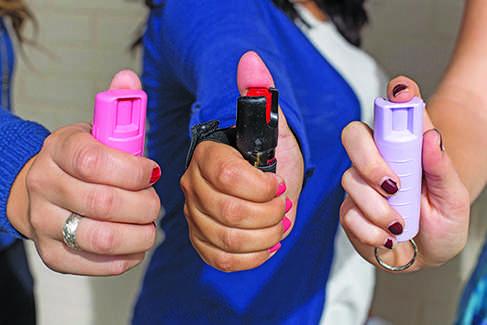Table of Contents
- Understanding Pepper Sprays as a Personal Safety Tool on Campus
- Legal Considerations and Campus Carry Policies Affecting Students
- Balancing Safety and Responsibility: Best Practices for Using Pepper Spray
- Recommendations for Enhancing Campus Security through Informed Self-Defense Choices
- Wrapping Up
Understanding Pepper Sprays as a Personal Safety Tool on Campus
When considering personal safety options on campus, pepper spray stands out as an effective and non-lethal self-defense tool. Its chemical formulation causes an immediate inflammatory response in the eyes and respiratory system of an attacker, enabling a quick chance for escape and alerting others nearby. Unlike other security devices, pepper spray is compact, lightweight, and easy to carry discreetly in backpacks or pockets, making it a practical choice for students navigating crowded or unfamiliar environments. Additionally, its use does not require extensive physical strength or training, which empowers individuals of all sizes and abilities to protect themselves confidently.
Key benefits of pepper spray include:
- Rapid incapacitation of threats, buying crucial seconds to reach safety
- Minimal risk of permanent injury, focusing on temporary deterrence
- Legal acceptance and regulation tailored in many regions for personal defense
For students, understanding local campus policies is essential, as regulations governing the possession and use of pepper spray vary widely. Many institutions require students to register their devices or restrict their use to specific scenarios. Familiarizing oneself with these rules ensures compliance and responsible usage, forming a key part of any smart personal safety strategy on campus.
Legal Considerations and Campus Carry Policies Affecting Students
Understanding the interplay between campus carry policies and the use of pepper sprays is crucial for students navigating their personal safety on university grounds. Laws vary widely by state and institution, often dictating what is permissible in dorm rooms, classrooms, and public areas. While some campuses strictly prohibit firearms regardless of local laws, pepper sprays tend to be more accepted as a non-lethal self-defense option. However, students should be aware that even pepper spray use is sometimes restricted by size, concentration, or sales regulations. Ignorance of these legal nuances can lead to serious consequences, including disciplinary action or criminal charges.
To ensure compliance and safety, students should actively engage with campus policies and local laws. Here are some key considerations to keep in mind:
- Check your institution’s specific rules: Many universities publish clear guidelines on permitted self-defense tools and carry policies on their websites.
- Know state legislation: Pepper spray laws vary by state regarding allowable concentrations and age restrictions.
- Carry responsibly: Misuse of any self-defense product can lead to severe penalties-always use them as a true last resort.
- Stay informed about updates: Campus and state policies can evolve, especially with ongoing debates about campus safety.
Balancing Safety and Responsibility: Best Practices for Using Pepper Spray
When carrying pepper spray on campus, it’s crucial to understand that safety begins with informed and responsible use. Students should familiarize themselves with local regulations and campus policies to avoid legal complications. Before carrying pepper spray, practice handling the device safely-know how to unlock, aim, and deploy it quickly under pressure. This preparedness not only maximizes effectiveness but also minimizes accidental discharge, protecting both the user and those nearby. Remember, pepper spray is a defensive tool, not an offensive weapon; its purpose is to deter threats and create a window for escape.
Balancing safety with responsibility also means maintaining awareness and respect for others while using pepper spray. Consider these best practices to ensure a safer campus environment:
- Store the spray in an accessible yet secure location on your person, such as a keychain or pocket holster.
- Only deploy pepper spray when you genuinely feel threatened, avoiding misuse or unnecessary escalation.
- Regularly check the expiration date and replace outdated cans to guarantee effectiveness.
- Inform trusted friends or campus security about your safety plan, fostering community awareness.
- Attend self-defense workshops that include pepper spray techniques to improve confidence and control.
By integrating these habits, students can leverage pepper spray as a practical layer of protection while respecting ethical and legal boundaries, fostering a safer and more responsible campus community.
Recommendations for Enhancing Campus Security through Informed Self-Defense Choices
Empowering students with knowledge about their self-defense options is pivotal in creating a safer campus environment. Institutions should prioritize educational workshops and training sessions that detail the legalities, use, and limitations of pepper sprays and other non-lethal defense tools. These initiatives not only boost confidence but also foster responsible usage among the student body. Additionally, collaborating with local law enforcement to provide scenario-based training can sharpen students’ situational awareness and decision-making skills, ensuring they are prepared without resorting to excessive force.
Practical measures to consider include:
- Facilitating easy access to approved pepper spray products in campus stores with verification checks.
- Implementing clear policies that delineate when and how pepper sprays can be carried and used on campus.
- Offering comprehensive resources-both online and offline-highlighting self-defense strategies beyond pepper sprays, such as safe escape routes and de-escalation techniques.
- Encouraging peer-support networks to nurture a community-first approach toward safety, where students look out for each other.
Wrapping Up
In today’s evolving campus landscape, the conversation around pepper sprays and campus carry policies remains as crucial as ever. While ensuring student safety is a shared priority, striking the right balance between personal protection and a secure learning environment calls for thoughtful dialogue and informed decision-making. By staying educated about the tools available and advocating for clear, consistent regulations, students and institutions alike can work together to foster campuses where everyone feels safe and supported. As these discussions continue, one thing is clear: empowering students with knowledge and options is a vital step toward a safer tomorrow.Check Our Other Blogs
- StunGun – Your Trusted Source for Stun Guns, Laws, and Self-Defense Tips
- PepperSprayLaws – Your Trusted Resource for Pepper Spray Information
- StunGunLaws – Your Trusted Guide to Stun Gun Legality and Safety




